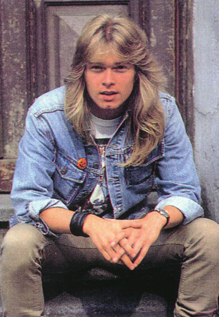
Lead vocals (former)
Birthday:
January 24, 1968
Birthplace:
Hamburg, Germany
Height:
181cm
Weight:
65kg
Thing Most Impressed By:
The speed of some Helloween songs.
Most Important thing:
Music.
Things Fear Most:
If it would always be cold.
Person admire most:
Elvis Presley, Bruce Dickinson.
Philosophy of life:
Fun.
Unrealizable Ambition:
To be an astronaut.
Ideal day:
One half of the day lying in the sun.
The other half playing with Madden.
If you were an animal, which would you be and why?
A bird, because flying is great.
Michael Kiske's career began when he was the vocalist of a band called VII Prophecy. Meanwhile, another German band, Helloween was looking for a vocalist, since its leader, vocalist and guitarist didn't tolerate more to sing and to play guitar at the same time. With the formation of the band in order, they decided to call that young 18 year old vocalist endowed with an incredible voice. Together in Helloween, they recorded the second album of the band, entitled "Keeper of the seven keys Part 1, released in 1987. After the success of the first part of the Keepers, the second album, "Keeper of the seven keys Part 2, released in 1988, gained the same success as the previous. But the dream came to a halt when, after internal conflicts, the leader of Helloween, Kai Hansen, decided to leave the band and make a solo work near his friends. Consequently and with problems with the recording company, the musical style of Helloween began to change, until they only released a singles collection in 1989 just to keep the sales up. Kai Hansen was substituted by Roland Grapow, coming from a band call Rampage. Helloween then recorded their new album, released in 1991, called "Pink bubbles go ape", that was considered bad by most of the older fans of the band. In that time, conflicts between Michael Kiske and the other members of the band grew more intense. Even with those conflicts, they set out to the recording of their next album, called "Chameleon", released in 1993, considered by the fans the worst album in the career of Helloween. That was the final period of the permanence of Kiske, who left along with Ingo Schwichtenberg, who suffered of mental problems, and didn't get to play more. Michael Kiske, already out of Helloween, he began to prepare his own solo album, and in elapsing of that time, he made a special participation in a Gamma Ray album, the old leader's of Helloween band and friend, Kai Hansen. Three years after having left Helloween, in 1996, Michael Kiske throws his solo album called "Instant Clarity", that counts with Kai Hansen's special participation, and Adrian Smith (Iron Maiden), and whose style differs from the old work of Helloween. Few months after the release of that album, he released an EP, "The Calling", that counts with two unpublished tracks. Now, Michael Kiske is preparing his new album, that will have a more classic style, and that will count with the participation of orchestras.